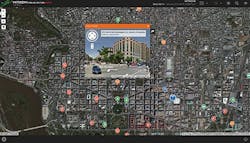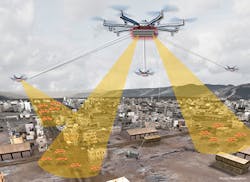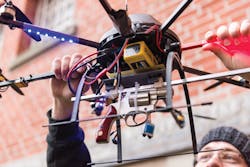The dawn of counter-drone technologies
The proliferation of relatively inexpensive unmanned aerial vehicles (UAVs) that can carry spy cameras or powerful explosives gives a sense of urgency to protecting airports, power plants, prisons, and military bases from the drone threat.
By J.R. Wilson
One of the most frequently heard terms in the military and commercials worlds today is "disruptive technology" - something that so significantly changes the way things are done that entire industries and practices disappear as new ones arise. Small, cheap unmanned aerial vehicles (UAVs), easily available to anyone anywhere, are a major example of a disruptive technology.
While the U.S. military has dominated 21st century battle spaces with capable, sometimes armed, UAVs, nearly every nation and military on Earth is acquiring UAVs or building their own. That has led to the need for a counter-UAV (C-UAV) capability to defend U.S. and allied forces and critical infrastructure from enemy UAV surveillance, electronic warfare, and conventional attack.
Today's commercially available UAVs can carry surveillance cameras or a brick of powerful explosives. These miniature unmanned aircraft also are available to almost anyone over the Internet. This not only has created another level of threat for the military, but also has expanded the danger to power plants, sports arenas, ships, railroads, and pipelines.
While most small UAVs are operated legally, the threat from "bad actors" flying similar UAVs in the same airspace grows exponentially. This is creating a wide range of new industries, from legal practices specializing in UAV-based lawsuits or criminal charges to manufacturing and maintenance companies to a new generation of specialized small sensors to C-UAV systems.
Counter-UAV technologies are much like the armor/anti-armor developments prevalent in the last century: Build a stronger armor and someone will build a new way to pierce it. Build a better C-UAV capability and someone will create a new counter-C-UAV.
"All these C-UAV capabilities will lead to counter-counter - how do you make the drone unhackable. So it's a UAV/C-UAV arms race," says Michael Blades, senior aerospace and defense industry analyst at Frost & Sullivan in San Antonio, Texas.
Counter-drone cat-and-mouse
"While all these C-UAV companies are competing for this market, many are looking at a broad appeal that includes commercial requirements," Blades continues. "That has led to a search for synergies with other companies. Those same companies also are looking at hardening drones, something DARPA also is working on."
C-UAV is still in its infancy and many companies - large, small, and start-ups - only recently have begun looking at it as a prospective future high-growth market.
As with many others, experts at Hitachi Data Systems Federal in Reston, Va., began identifying the need about two years ago. A combination of in-house development and some technology acquisitions led to the marketing, about six months later, of the Hitachi Visualization Suite (HVS), which now has about two dozen active users.
"Within a geospatial format, with HVS you can see how disparate data correlates, not only geospatial but also time continuum. That covers everything from a college campus to very covert missions where you need to get real-time information out to the front line," explains Chris Jensen, director of HDS federal critical infrastructure, intelligence & investigative solutions at Hitachi Federal. "On the federal side, we added specific capabilities. We have our own design and development team to help us meet the need of a specific segment of the market."
He breaks down Hitachi's market segment into three parts: critical infrastructure, or anything from a sports stadium to a nuclear power plant; intelligence, or how to bring in information and create actionable intelligence out of it, then get that out to the end user; and investigative, or complex situations, such as conspiracies within the homeland or identifying and tracking terrorist cells internationally.
As with most high-tech areas today, the military is keeping a close watch on companies developing commercial products that the military could adapt for defense applications. Civilian markets also are benefitting from military developments, resulting in a complex and sometimes-contentious synergy.
"A lot of focus on the commercial side is being able to see the link between drone and operator and follow it back so the operator can be caught. It might not have been a malicious thing, but how do you know until you find the operator? So the commercial focus is detect and alert, then integrate into existing systems [for mitigation]," Blades says.
Countering drone swarms
"On the military side, a lot of top Army and Marine Corps brass are concerned about the potential for small, weaponized drone swarms. They don't think they really have a defense against that. So the military wants a multilayer detection capability and the option of either electronic or kinetic mitigation, depending on the area of operations, rules of engagement."
The potential threat from small UAVs in the hands of terrorists also has attracted the attention of regulatory agencies, such as the U.S. Federal Aviation Administration (FAA), which launched its Pathfinder Program in May 2015 as a partnership with industry to explore the next steps in unmanned aircraft operations beyond the type of operations the agency proposed in the draft small unmanned aircraft systems rule. The program began with three industry partners looking at possible UAV applications in different focus areas, all also vulnerable to potential UAV threats.
Cable News Network (CNN) in Atlanta is looking into visual line-of-sight operations for the safe use of UAVs for news gathering in urban areas.
PrecisionHawk in Raleigh, N.C., is exploring extended visual line-of-sight operations in rural areas to enable UAV flights outside the pilot's direct vision for crop monitoring in precision agriculture.
The BNSF Railway Co. in Commerce, Calif., is exploring beyond line-of-sight command-and-control challenges to using UAVs to inspect rail system infrastructure in rural and isolated areas.
CACI International Inc. in Arlington, Va., is evaluating how the company's technology can help detect UAVs flying near airports.
In 2016, the FAA further expanded Pathfinder by signing co-operative research and development agreements (CRDAs) with Liteye Systems Inc. in Centennial, Colo.; Sensofusion USA in New York; and Gryphon Sensors LLC, an SRC company in North Syracuse, N.Y.
Liteye is the North American manufacturing and integration partner for three British developers working together on the Anti-UAV Defence System (AUDS) - Blighter Surveillance Systems in Great Chesterford, England; Chess Dynamics Ltd. in Horsham, England; and Enterprise Control Systems Ltd. in Wappenham, England. The CRDA calls for Liteye to test the AUDS integrated detect-track-disrupt-defeat C-UAV system at U.S. airports selected by the FAA.
AUDS integrates Blighter's A400 series Ku-band electronic scanning air security radar; Chess Dynamics' stabilized electro-optic director, infrared and daylight cameras, and target tracking software; and an Enterprise directional radio frequency (RF) inhibitor to detect, track, classify, disrupt, and defeat UAVs as far away as six miles. The team claims AUDS also is effective against Group 1 micro and mini UAVs at ranges of several miles.
UAV-aircraft near misses
More than 100 pilot reports occur every month about UAVs flying too closely to U.S. airports and commercial aircraft. This has created a major safety concern for the FAA, and a security issue for the U.S. Department of Homeland Security (DHS).
"AUDS is able to operate effectively in complex airport environments night and day, whatever the weather, and without disrupting other airport equipment. Using AUDS, the operator can effectively take control of a drone and force a safe landing inside or outside the airport perimeter," according to Mark Radford, speaking on behalf of the British/American team.
"The system can also assist airport authorities to track down the UAV pilots for prosecution by providing evidence - video footage or radar tracks - to the relevant authorities. We can also integrate 'friendly assets' into the AUDS platform - for example, a 'friendly' drone - to extend the threat detection and situational awareness capabilities of the system and to help capture rogue drone pilots," Radford says.
Sensofusion will test its AIRFENCE system, already being used in Europe to help secure high-profile government buildings, police and military sites, and prisons, as a C-UAV candidate to defend U.S. airports from hostile or intrusive UAVs.
"We first developed the technology to detect, locate, track, and gain control over UAS three years ago as a military project and operated it with three European armies under NATO," says Sensofusion CEO Tuomas Rasila.
Gryphon will test a prototype UAV sensor detection system at FAA-selected airports. "Detecting these threats is challenging because most of them are very small, fly low to the ground, and can be pre-programed to fly autonomously," notes company president Tony Albanese.
"We anticipate receiving valuable data from each of these trials that could result in FAA-approved operations in the next few years. They will also give insight into how unmanned aircraft can be used to transform the way certain industries do business - whether that means making sure trains run on time, checking on the health of crops, or reporting on a natural disaster," FAA Administrator Michael Huerta says. "[Our industry partners] reached out to the FAA to work with us on exploring [unmanned operations and] have committed extensive resources to perform research that will help us determine if and how we can safely expand unmanned aircraft operations in the United States."
Many aerospace companies of all sizes - some with UAV backgrounds, some without - have joined the C-UAV effort.
Growing counter-UAV effort
Airbus Defence and Space in Toulouse, France, has developed a C-UAV System combining the company's radars, IR cameras, and direction finders with state-of-the-art data fusion and signals analysis. The system can identify an approaching drone and assess its threat potential at ranges between 3.1 and 6.2 miles, then offer electronic countermeasures like its Smart Responsive Jamming Technology, to minimize the risk of collateral damage.
"As a specialist in defense electronics, we have all the technologies in our portfolio and the integration knowledge needed to set up a quick-response protection system with extremely low false alarm rates," claimed Thomas Müller, head of electronics and border security at Airbus Defence and Space.
Another United Kingdom company - Drone Defence in Doncaster, England - recently announced what it calls Drone Defenders, former military and law enforcement personnel trained to use the Dedrone DroneTracker to detect and identify unauthorized UAVs, then employ either the company's man-portable Dynopis E1000MP to jam the UAV's controls or its Net Gun X1 C-UAV system to capture the aircraft. Operating from either a fixed location or as a mobile unit, DroneTracker uses acoustic, optical, and infrared sensors for real-time detection and identification.
In September, Van Cleve & Associates in Alexandria, Va., and Open Works Engineering in Riding Mill, England, bested six other international competitors to win the non-profit Mitre Corp. Countering Unmanned Aircraft Systems Challenge.
Van Cleve's DroneRanger was declared the best end-to-end system and best detection tool for interdicting small UAVs, while the Open Works SkyWall 100 won in the interdiction system category. The other finalists were:
- the DroneTracker from DeDrone GmbH in Kassel, Germany;
- the Mesmer platform Department 13 International in Columbia, Md.;
- the Icarus system from Lockheed Martin Corp.;
- the Knox platform from MyDefense Communications in Sundby, Denmark;
- the Dronebuster system from Radio Hill Technology in Portland, Ore.; and
- the DroneBlocker tool from TrustComs/Trifecta Global in Versailles, France.
MITRE C-UAS Challenge entrants from around the globe were asked for solutions that could detect drones smaller than five pounds during flight and determine which were threats, based on geographic location and flight trajectory, then interdict those perceived as threats by forcing them to land in a safe area for intact recovery.
Counter-drone research
The U.S. Defense Advanced Research Projects Agency (DARPA) in Arlington, Va., is investigating C-UAV, for future applications and more near-term use. Two of those are Aerial Dragnet and the Multi-Azimuth Defense Fast Intercept Round Engagement System (MAD-FIRES).
The 13 September 2016 Broad Area Announcement DARPA issued for Aerial Dragnet described the need and the goal for persistent wide-area surveillance of multiple small UAVs in urban terrain on a citywide scale. "Small UAS [unmanned aircraft systems] are rapidly becoming low-cost aerial platforms for hostile reconnaissance, targeting, and weapon delivery," DARPA officials say.
Unlike traditional air targets, small UAVs fly at altitudes lower than 400 feet above the ground, which make them easily hidden by complex terrain. These small unmanned aircraft also move more slowly than 90 knots, which makes them difficult to differentiate from other movers. These unmanned aircraft also are smaller than 55 pounds, making them difficult to sense.
"In future urban battlegrounds, U.S. forces will be placed at risk by small UAS that use buildings and naturally occurring motion of the clutter to make surveillance impractical using current approaches," DARPA officials say. "The rapid proliferation of commercial UAS with increasing endurance and payload capacity drives the need for a future urban aerial surveillance system that can detect, track, and classify many different UAS types at longer ranges in urban terrain."
Existing C-UAV approaches, the DARPA Aerial Dragnet solicitation continues, rely either on line-of-sight (LOS) target viewing not possible in urban terrain, or exploit fragile vulnerabilities of commercial UAVs.
"This program seeks to develop systems for threat-agnostic non-line-of-sight (NLOS) surveillance that exploit and adapt to the fundamental physics of the threat and the urban environment," the Aerial Dragnet solicitation says. "To achieve wide-area performance, proposals are solicited for a scalable network of surveillance nodes, each consisting of sensors mounted on a persistent unmanned aerial platform that can sense over and into complex terrain. The resulting system will produce real-time situational awareness of the airspace in urban areas below altitudes covered by conventional air surveillance systems."
Program Manager Jeff Krolik says real-time linkage of Aerial Dragnet's multiple UAVs and sensors can provide a comprehensive network for persistent wide-area surveillance of all low-flying UAVs in an urban setting. "Commercial websites currently exist that display in real-time the tracks of relatively high and fast aircraft - from small, general aviation planes to large airliners - all overlaid on geographical maps as they fly around the country and the world," Krolik says. "We want a similar capability for identifying and tracking slower, low-flying unmanned aerial systems, particularly in urban environments."
Counter-drone surveillance
The program office anticipates achieving that goal through innovative networking of surveillance nodes, perhaps mounted on tethered or long-endurance UAVs, to cover neighborhood-sized urban areas. Using sensor technologies to look over and between buildings, the nodes could maintain UAV tracks even when the aircraft disappears around corners or behind objects.
Aerial Dragnet's sensor data would inform a continually updated common operational picture (COP) of the airspace at altitudes below where current aircraft surveillance systems can monitor, using secure data links to electronically disseminate it to authorized users. DARPA says the program also will focus on combining low-cost sensor hardware with software-defined signal processing hosted on existing UAVs, resulting in cost-effective, scalable urban coverage and rapid upgradeability as new, more capable and less expensive technologies become available.
DARPA's MAD-FIRES program is strictly for military use, although it may yield some commercially valu- able anti-drone technologies. MAD-FIRES was created in response to an escalating rate of attacks by unmanned vehicles, missiles, small planes, fast attack craft, and other platforms posing "a perennial, evolving, and potentially lethal threat to ships and other maritime vessels." Those risks, combined with ever-morphing threats, make leading-edge defensive air and surface combat technologies critical. That is especially true for ships equipped with current close-range gun systems, enhancing their ability to rapidly and with high precision engage a swarm of diverse targets coming from a range of directions.
"The goal of the program is to design and develop technologies associated with a medium-caliber guided projectile that would combine the guidance, precision and accuracy generally afforded by missiles with the speed, rapid-fire capability, and large ammunition capacity afforded by bullets," explains MAD-FIRES Program Manager Jerome Dunn.
"MAD-FIRES aims to advance the state-of-the-art in defensive gun systems by creating a new, low-cost technological foundation for guided, gun-launched projectiles. Specifically, MAD-FIRES aims to incorporate enhanced ammunition rounds able to alter their flight path in real time to stay on target and a capacity to continuously target, track, and engage multiple fast-approaching targets simultaneously and re-engage any targets that survive initial engagement," Dunn says.
Rapidly evolving technologies
The future of small UAVs as a threat to military and civilian infrastructure - and human lives - and the level of success achieved through dozens of C-UAV efforts involving a host of different sensors and mitigation technologies remains murky, but rapidly evolving.
"On the defense side, you'll see more use at forward-deployed locations, integrating C-UAV into existing perimeter security systems, such as tethered aerostats, to cover more area. You'll see more deployable systems that can be easily transitioned to a mobile capability. Northrop Grumman recently demonstrated a system where an app on a soldier's smartphone can use its microphone to detect small drones. The range probably isn't great, but if every soldier is a sensor, that would help detect and triangulate," says Hitachi Federal's Jensen.
"On the commercial side, you'll see a lot more interest as proliferating small commercial drones get used for more and more applications. Companies won't want them flying over their test sites, the public won't want them flying over their homes. Stadiums, prisons, will show a much greater interest as people gain more ideas on what they can use drones for, including bad uses. So there will be lots of investment and attempts to defeat all kinds of drones and swarms, plus how to then defeat those. And that will just keep going back and forth," Jensen says.
While concern is growing about the kind of threats posed in a world filled with small, but increasingly versatile UAVs and hundreds of millions of dollars are being devoted worldwide to develop C-UAV technologies, reality may be lagging behind perception, at least for now, says Frost & Sullivan's Blades.
"It's a perceived threat. Whether that is real now is questionable. If it is a threat, why wasn't it one long ago with model airplanes? Granted, once you take off a fixed-wing model airplane, there's not a lot it can do between take-off and landing, while the more maneuverable UAV can get into smaller, more confined spaces," Blades says.
"C-UAV is almost all sensor-based, with the military spending millions on better sensors with better SWaP, which has driven a lot of innovation," Blades adds. "For now, the capability of inexpensive rotor-wing drones and autonomy is not yet to the point where a terrorist cell could get 20 or 30 drones and send them out in a swarm attack. It's probably not that far off."






